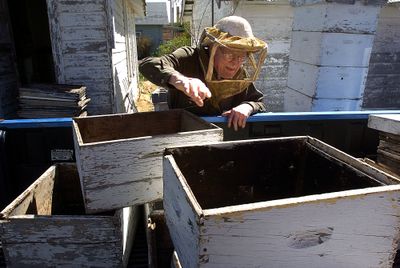Waldo McBurney, 106, named oldest worker in U.S.

Waldo McBurney, who was named America’s oldest worker and gained fame in his later years as a competitive runner and beekeeper, died Wednesday. He was 106.
McBurney, whose life spanned an age of horse-drawn buggies to computers, died at the Gove County Medical Center in his hometown, according to the Schmitt Funeral Home in Quinter.
In 2006, he was named America’s oldest worker by the Washington-based Experience Works, which provides training and employment for senior citizens. At 104 he was spry and agile, walking most days the few blocks from his home to his office in the High Plains farming community of Quinter, Kan.
As a child, he got his first paying job at 13 guiding the lead team of horses pulling a wheat thrasher. He started a seed-cleaning business in the 1950s and ran it until he was 91.
McBurney then turned his decades-old hobby of beekeeping into a honey business, which he sold last year after saying he was slowing down.
George Shor Jr., 86, geophysicist and mentor
George Shor Jr., the geophysicist whose studies of the ocean floor helped lay the foundation for the theory of tectonic plates and continental drift, died July 3 at his home in San Diego of complications following a series of strokes. He was 86.
He helped develop the nation’s fleet of ocean-going research vessels, was a principal in the abortive Project Mohole to drill a hole deep into the Earth, and played a key role in creation of the California Sea Grant program, which funds marine and coastal research.
“He mentored students ashore and at sea, but his strength was teaching people geophysics at sea,” said geologist Robert L. Fisher, a professor emeritus at the Scripps Institution of Oceanography, where Shor spent most of his career.
Shor’s work and that of others eventually led to the conclusion that the planet’s continents reside on massive tectonic plates that are adrift on the ocean of volcanic magma far below the Earth’s surface, pulling apart in some areas to create deep trenches in the ocean and jamming together in others to create massive mountain ranges.
John Bachar, 52, rock climber known for free-solo exploits
John Bachar, a legendary figure in the world of rock climbing, died last Sunday after a fall near his home in Mammoth Lakes, Calif. He was 52.
Bachar fell while climbing alone on Dike Wall outside of Mammoth Lakes. Nearby climbers heard the fall and quickly reached Bachar, who was rushed to Mammoth Hospital, where he died of severe injuries.
Bachar, who was born in Los Angeles in 1957 and attended the University of California, Los Angeles, became famous largely for his exploits as a free-soloist. He practiced the most dangerous form of climbing because it does not involve ropes or safety equipment.
Bachar is perhaps best known for his first ascent of the Bachar-Yerian route in Yosemite’s Tuolumne Meadows, which he conquered with Dave Yerian in 1981. That same year Bachar posted a note in Yosemite offering a “$10,000 reward for anyone who can follow me for one full day.” Nobody accepted the challenge.
Bob Mitchell, 96, organist for Dodgers and silent films
Bob Mitchell, an organist who was the first such house musician at Dodger Stadium and the last surviving working accompanist from the silent-film era, has died. He was 96.
Mitchell died Saturday from congestive heart failure at Hancock Park Rehabilitation Center in Los Angeles, said Vincent Morton, his caregiver.
When the Los Angeles Dodgers opened at their new stadium in Chavez Ravine in 1962, so did Mitchell – on a Wurlitzer double-keyboard organ with a 25-note pedal board. At the time, he was best known as founder and director of a group often called the Robert Mitchell Boys Choir, which would appear in more than 100 movies.
His career as choir director was framed by two stints as a silent-movie organist, played out more than 60 years apart. One of his last performances was in early June at the Silent Movie Theatre, where he was first featured in 1992. He helped create “a true revival of cinema on the highest level,” said Charlie Lustman, who owned the theater from 1999 to 2006.